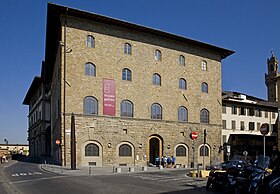Museo Galileo

Institute and Museum of the History of Science
|
|
| Location | Piazza dei Giudici 1, Florence, Italy |
|---|---|
Museo Galileo, the former Istituto e Museo di Storia della Scienza (Institute and Museum of the History of Science) is located in Florence, Italy, in Piazza dei Giudici, along the River Arno and close to the Uffizi Gallery. It is housed in Palazzo Castellani, an 11th-century building which was then known as the Castello d’Altafronte. Museo Galileo owns one of the world’s major collection of scientific instruments, which bears evidence of the crucial role that the Medici and Lorraine Grand Dukes attached to science and scientists. The Museo di Storia della Scienza re-opened to the public under the new name Museo Galileo on June 10, 2010, after a two-year closure due to important redesigning and renovation works. It was inaugurated just four hundred years after the publication in March 1610 of Galileo’s Sidereus Nuncius (The Starry Messenger), the booklet that revolutionized mankind’s conception of the universe, decisively contributing to the advent of modern science.
The museum features the valuable scientific instruments from the Medici Collections which were first displayed in the Stanzino delle Matematiche (Mathematics Room) in the Uffizi Gallery. They were later on moved to the Museo di Fisica e Storia Naturale (Museum of Physics and Natural History) founded by Grand Duke Peter Leopold in 1775. During the reign of the Lorraine Grand Dukes, new instruments were added to the scientific collections. In 1929, the First Italian Exhibition of the History of Science in Florence highlighted the importance of scientific collections within Italy’s cultural heritage. As a consequence, in 1930 the University of Florence gave birth to the Istituto di Storia della Scienza con annesso Museo (Institute of the History of Science and attached Museum). The Institute was housed in Palazzo Castellani and was entrusted with the instrument collections of the Medici and Lorraine dynasties. The permanent exhibition is arranged by chronological and thematic paths.
The first floor’s nine rooms are devoted to the Medici Collections, dating from the 15th century through the 18th century. The permanent exhibition includes all of Galileo’s unique artifacts, among which are his only two extant telescopes and the framed objective lens from the telescope with which he discovered the Galilean moons of Jupiter; thermometers used by members of the Accademia del Cimento; and an extraordinary collection of terrestrial and celestial globes, including Santucci's Armillary Sphere, a giant armillary sphere designed and built by Antonio Santucci.
...
Wikipedia
